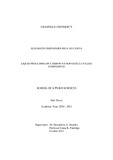JavaScript is disabled for your browser. Some features of this site may not work without it.
| dc.contributor.advisor | Skordos, Alexandros A. | |
| dc.contributor.advisor | Partridge, Ivana K. | |
| dc.contributor.author | Fernandez Reia Da Costa, Elisabete | |
| dc.date.accessioned | 2012-06-25T14:15:06Z | |
| dc.date.available | 2012-06-25T14:15:06Z | |
| dc.date.issued | 2011-10 | |
| dc.identifier.uri | http://dspace.lib.cranfield.ac.uk/handle/1826/7276 | |
| dc.description.abstract | This thesis focuses on the incorporation of carbon nanoparticles within continuous fibre reinforcements by liquid composite moulding processes, in order to provide enhanced electrical and delamination properties to the multiscale composites. The mechanisms controlling the flow and filtration of these nanoparticles during liquid composite moulding are studied, in order to develop a predictive 1-D model which allows design of the processing of these composite materials. Five different carbon nanoparticles at 0.25 wt% loading, three unmodified and one surface modified carbon nanotube systems and one carbon nanofibre system, were utilised to modify a commercial two-component epoxy resin utilised to impregnate carbon and glass reinforcements at high fibre volume fraction by resin transfer moulding. The dispersion of the nanofillers in the prepolymer was carried out by ultrasonication, high shear mixing or triple roll milling or a combination of the three. Electrical conductivity measurements of the carbon nanoparticle liquid suspensions during dispersion, alongside optical microscopy imaging and rheological analysis of these allowed the selection of the concentration of nanofiller and the appropriate dispersion technique for each nanoparticle system. The resin transfer moulding process required adaptation to incorporate the dispersion and modify degassing steps, especially when utilising unmodified carbon nanoparticles suspensions, due to their higher viscosity and tendency to be filtered. Nanoparticle filtration was identified by electrical conductivity measurements and microscopy of specimens cut at increasing distances from the inlet. Cake filtration was observed for some of the unmodified systems, whereas deep bed filtration occurred for the surface modified CNT material. Property graded composites were obtained due to filtration, where the average electrical conductivity of the carbon and glass composites produced increased by a factor of two or one order of magnitude respectively. The effect of filler on the delamination properties of the carbon fibre composites was tested under mode I. The results do not show a statistically significant improvement of delamination resistance with the presence of nanoparticles, although localised toughening mechanisms such as nanoparticle pull-out and crack bridging as well as inelastic deformation have been observed on fracture surfaces. Particle filtration and gradients in concentration resulted in non-linear flow behaviour. An 1-D analytical and a finite difference model, based on Darcy’s law accompanied by particle mass conservation and filtration kinetics were developed to describe the flow and filtration of carbon nanoparticle filled thermosets. The numerical model describes the non-linear problem by incorporating material property update laws, i.e. permeability, porosity and viscosity variations on concentration of retained and suspended particles with location and time. The finite difference model is consistent and converges to the analytical solution. The range of applicability of the analytical model is limited to lower filtration coefficients and shorter filling lengths, providing an approximate solution for through thickness infusion; whereas the numerical model presents a solution outside this range, i.e. in-plane filling processes. These models allow process design, with specified carbon nanoparticle concentration distributions achieved via modifying the nanofiller loading at the inlet as a function of time. | en_UK |
| dc.language.iso | en | en_UK |
| dc.publisher | Cranfield University | en_UK |
| dc.rights | © Cranfield University 2011. All rights reserved. No part of this publication may be reproduced without the written permission of the copyright owner. | en_UK |
| dc.subject | dispersion | en_UK |
| dc.subject | RTM | en_UK |
| dc.subject | flow | en_UK |
| dc.subject | filtration | en_UK |
| dc.subject | modelling | en_UK |
| dc.subject | finite differences | en_UK |
| dc.subject | electrical conductivity | en_UK |
| dc.subject | delamination | en_UK |
| dc.title | Liquid moulding of carbon nanoparticle filled composites | en_UK |
| dc.type | Thesis or dissertation | en_UK |
| dc.type.qualificationlevel | Doctoral | en_UK |
| dc.type.qualificationname | PhD | en_UK |
